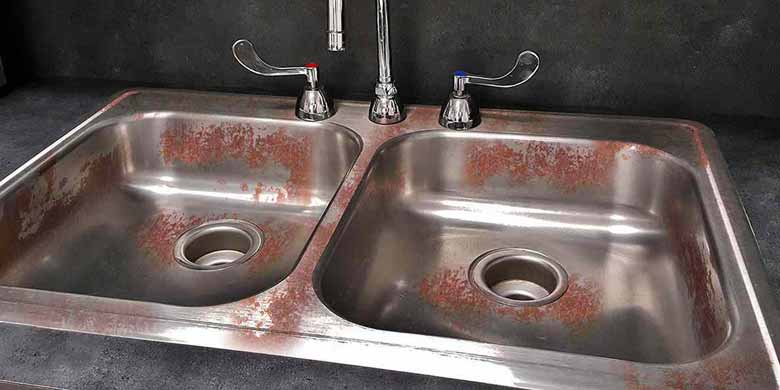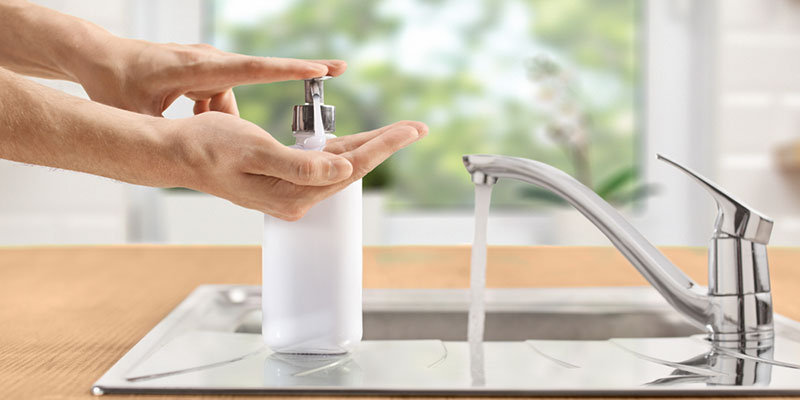The Best Way How To Season Cast Iron Grill Pan

Season Cast Iron Grill Pan
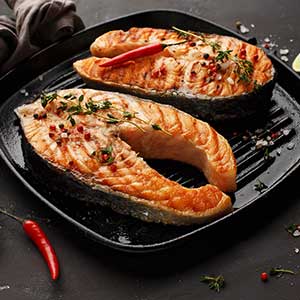 Taking care of the kitchen appliances is similarly important for one who is a novice to the kitchen and one who is a master chef. Learning how to season cast iron grill pan is a crucial point while it’s about taking care of the appliances.
Taking care of the kitchen appliances is similarly important for one who is a novice to the kitchen and one who is a master chef. Learning how to season cast iron grill pan is a crucial point while it’s about taking care of the appliances.
If you skip the season or re-season part, there are risks of losing your pan’s non-stick cooking surface and developing rust in it.
However, you surely do not want these to happen to your pans, right?
That’s not a problem, this article will cover all relevant information regarding this topic. Let’s get started!
What is Seasoning?
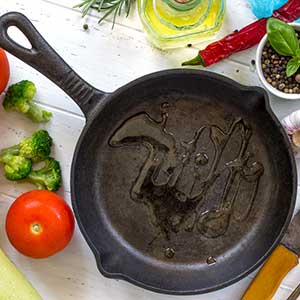 In simple words, seasoning is a process to protect your cast iron pans against rust. It is simply an oil-coating onto cast iron through the ‘polymerization’ process. It offers your pans and pots a natural, easy-release, non-stick cooking surface.
In simple words, seasoning is a process to protect your cast iron pans against rust. It is simply an oil-coating onto cast iron through the ‘polymerization’ process. It offers your pans and pots a natural, easy-release, non-stick cooking surface.
You need to use oil and heat to form that protective layer on top of your grill pan. Consequently, the oil bonding’s polymers will bind with the iron and create a naturally corrosion-resistant and stick-resistant coating.
Although this will always happen slightly whenever you cook using oil, you need to season it separately to take proper care of your grill pan.
Why You Should Season Your Cast Iron Pan
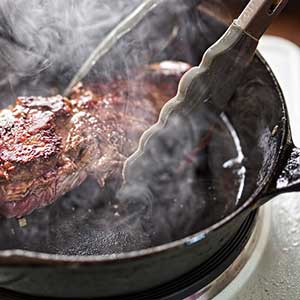 Seasoning is not crucial only for a grill pan but also for other cast iron pans (e.g skillet, dutch oven). If you use these pans without seasoning regularly, they will rust rapidly while being heated in the presence of water and oxygen. Moreover, foods will result in sticking to unseasoned cast iron pans.
Seasoning is not crucial only for a grill pan but also for other cast iron pans (e.g skillet, dutch oven). If you use these pans without seasoning regularly, they will rust rapidly while being heated in the presence of water and oxygen. Moreover, foods will result in sticking to unseasoned cast iron pans.
Since seasoning offers you to get a cast iron pan with a protection layer, it will let your pan get a longer lifespan. Moreover, you surely do not want your pans having rust spots that bear bacteria, do you? Not only this, rust can peel off into your food as well.
Also, if your cast iron pan loses the non-stick property, it will lead to burns on foods. And guess what? You will find it difficult to clean the burned-on food as well as you will not get the proper, delicious taste that you are supposed to get (just think about a burnt-flavored steak).
How to Season a Cast Iron Grill Pan?
Now, here we are getting into the heart of our conversation- how to season a cast iron grill pan. Learning the right steps is crucial, so, try your best to do things carefully. However, we have broken down the whole process into 5 easy steps. Let’s check them out.
Step 1: Clean Your Grill Pan
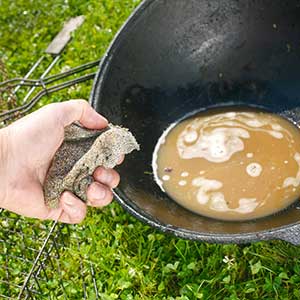 Well, this step is actually in the pre-seasoning process. If you are frowning your brows, let me say, it’s totally okay to scrub and clean your cast iron grill pan. It’s not going to damage your pan even if you use soap. You may have heard that soap is a culprit for damaging your pan, no it’s not.
Well, this step is actually in the pre-seasoning process. If you are frowning your brows, let me say, it’s totally okay to scrub and clean your cast iron grill pan. It’s not going to damage your pan even if you use soap. You may have heard that soap is a culprit for damaging your pan, no it’s not.
Once you are done with cooking, wash your cast iron grill pan with warm and soapy water. In case, you have burnt food or stubborn stains, then scrub the cooking surface with a scraper. You may think that it will remove some of the existing seasonings, but hey, you’re going to re-season the pan!
In case, you are still not okay with using soap, then use a little amount of kosher salt for the scrubbing purpose.
Step 2: Dry Your Pan
Once you’ve scrubbed your pans clean, make sure that the cooking surface is completely dry. You need the pan to be moisture-free for making sure that there is no rust particle being attracted.
You can simply set aside the pan and wait to dry or wipe off moisture from the cooking surface using a paper towel.
Step 3: Coat the Pan with Oil
Now it’s time to coat your cast iron grill pan with oil. You may use olive oil or any other alternative like vegetable oil (we’ve talked in detail about it below). So, first of all, take a little oil and rub it gently over the cooking surface. You can use a paper towel or simply a cloth for the rubbing purpose.
Make sure that you cover each square inch as well as get rid of excess oil.
Step 4: Place the Pan in Oven
When coating your pan with oil is done, bake your grill pan in the oven. What about the temperature to season the pan? Well, 450-degree Farenheight is the optimum temp.
Place your cast iron grill pan upside down in the preheated oven. Then let it bake for at least 1 hour and a maximum of 2 hours.
Step 5: Let the Pan Cool
So, this one is the last step you have to go through. Turn the oven off once you’re done with baking and leave the grill pan to cool down.
Once it’s cool enough to handle, store it in an appropriate place. Do not store cast iron grill pan in cupboards that may get in touch with high levels of moisture. Such as any cupboard that is above your stove may expose to a high level of moisture, so it isn’t wise to put the pan away.
How to Choose the Best Oil for Seasoning Cast Iron?
 Well, it is okay to season your cast iron grill pan using any kind of cooking oil. However, if you ask for the best option, we recommend using vegetable oil, canola oil, or melted shortening. ‘How can I say that these are the best?’ this question may pop up in your mind. Well, this statement is based on their effectiveness, availability, and affordability.
Well, it is okay to season your cast iron grill pan using any kind of cooking oil. However, if you ask for the best option, we recommend using vegetable oil, canola oil, or melted shortening. ‘How can I say that these are the best?’ this question may pop up in your mind. Well, this statement is based on their effectiveness, availability, and affordability.
Also, a worth noting point is the ‘smoke point’ of your oil. What it means is, the oil you’re using for the seasoning purpose needs to have a high smoke point. Because it’s crucial to heat your cast iron pan to the smoke point of that oil (for the process to work properly). So, if you use an oil that has a low smoke point, it will not bind properly. Also, oils with a low smoke point are easy to overheat. Consequently, there’s a chance to have a burned taste clinging to your pan.
You may think about whether you can use animal fats or not as they contain comparatively high smoke points. Well, actually, we do not recommend using these because in the long time of storage animal fats can turn rancid.
Moreover, it’s important to make sure that you heat the oven to the perfect temperature for the oil you use to season your grill pan. To make your path smoother, here’s a guide:
- Vegetable oil: 400-450℉
- Canola oil: 400℉
- Vegetable shortening: 360℉
- Flaxseed oil: 225℉
- Sunflower oil: 440℉
Best Cast Iron Grill Pan in a Video Review
Why Acidic Foods Are not Good for Your Cast Iron Pan
Yes, you need to be a bit picky about what foods you will cook with the cast iron grill pan, especially when you’re going to season a new cast iron grill pan for using a long period. So, what’s wrong with acidic foods? Well, cooking acidic foods with a new cast iron pan can damage the seasoning.
If it is an old cast iron grill pan, its seasoning layer is comparatively tougher. Consequently, it can stand up to acidic foods better than the fresh, new pans. However, you should avoid cooking acidic foods in both new and old cast iron grill pans. Also, try not to leave any leftover in your pan because the extended exposure to acidity may affect your seasoning.
How Often You Should Season Cast Iron Grill Pan
As you go through the seasoning process every time you’re cooking using oil, it’s not crucial to season your cast iron grill pan after every use. Yes, it is okay if you cook with it for days and weeks without seasoning.
But if you notice any rusting particles or food begins to stick/burn, it’s high time you reseasoned the pan after cleaning it.
Proper Ways to Remove Rust from Cast Iron
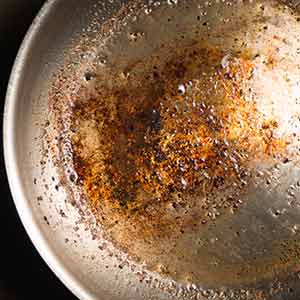 In case, your cast iron pan has got some rust particles, that’s okay, nobody is perfect! There are ways you can get rid of rust on your pans.
In case, your cast iron pan has got some rust particles, that’s okay, nobody is perfect! There are ways you can get rid of rust on your pans.
All you need to do is to scrub the affected areas using steel wool. Once you remove the rust, wash the pan and reseason it.
What if your pan is drastically rusty? Like, the majority of your pan’s surface is affected, then you need to follow any else method.
If this case happens to you, it’s better to talk to your local hardware store, they will help you go about this. When everything’s fine, wash and re-season the pan as usual.
Frequently Asked Questions
Conclusion
This was all about seasoning a cast iron grill pan. Are you still confused about any corner of this topic? Hopefully, your answer is negative as we left no stone unturned to make things crystal clear.
Happy Seasoning!

